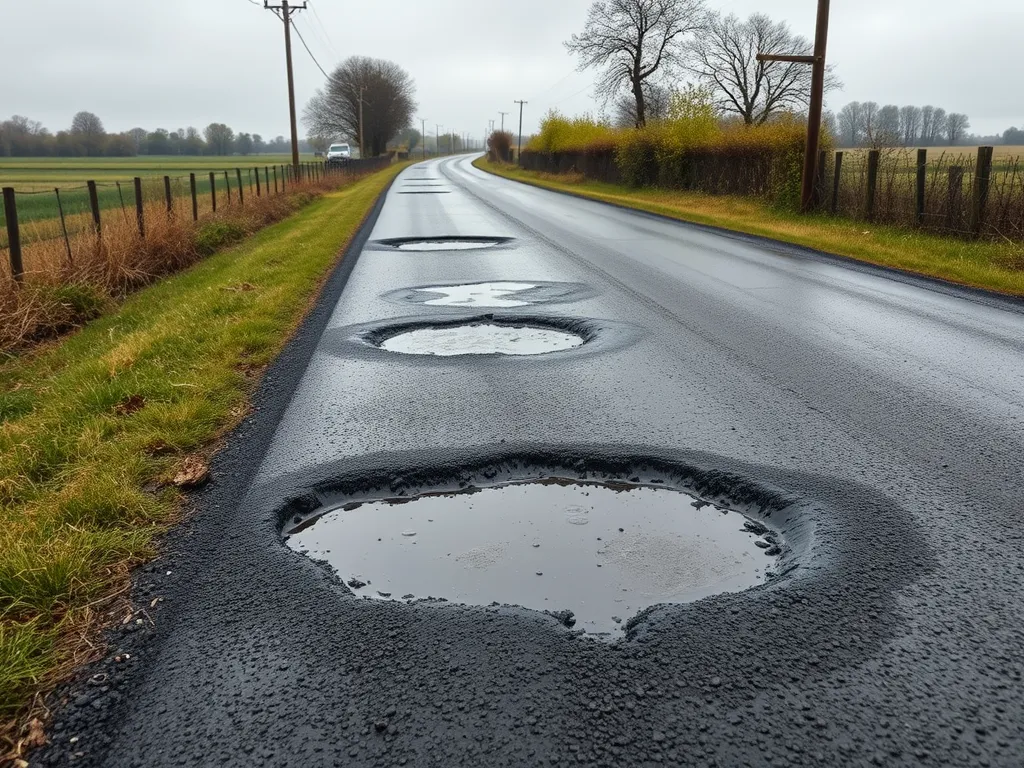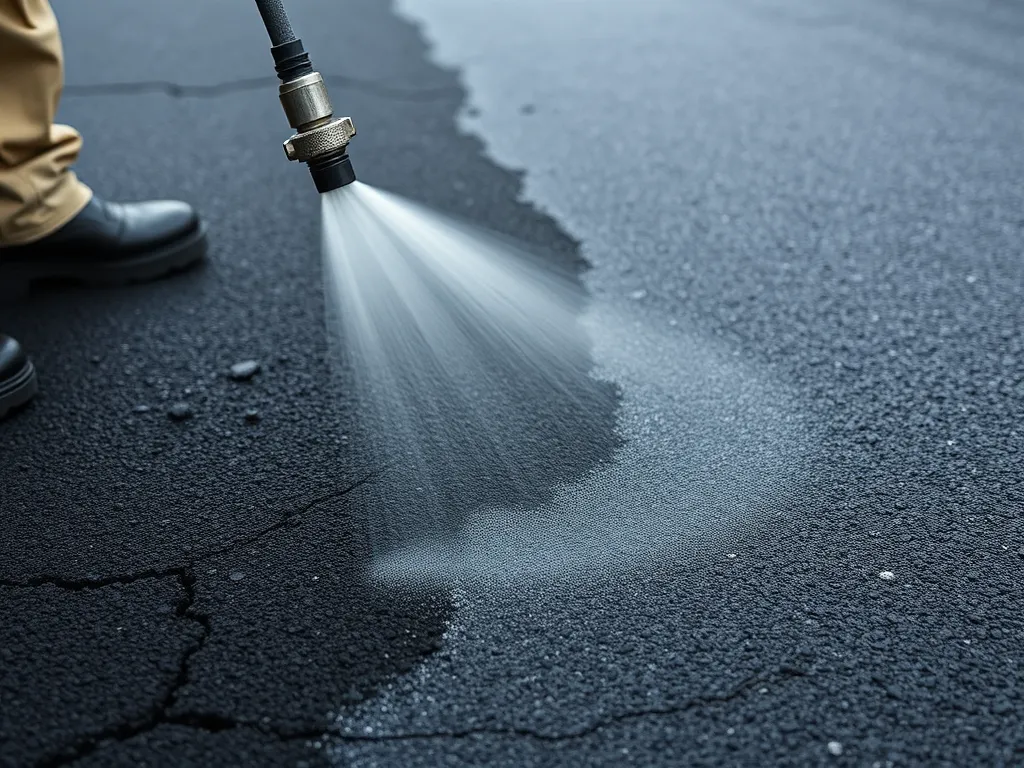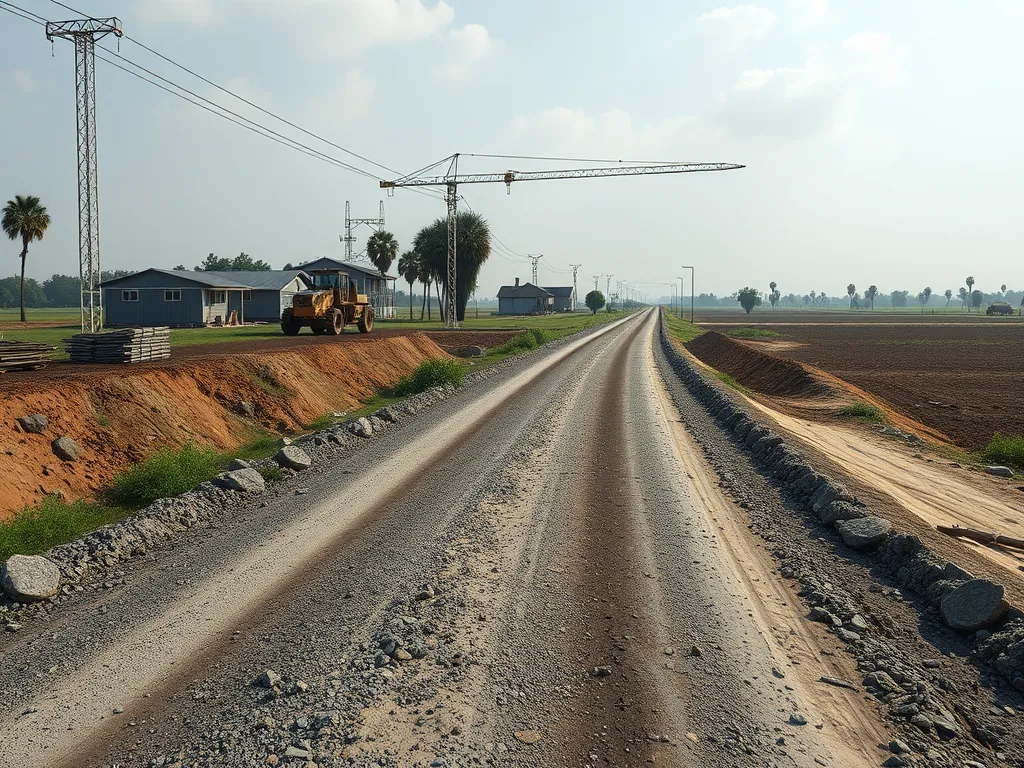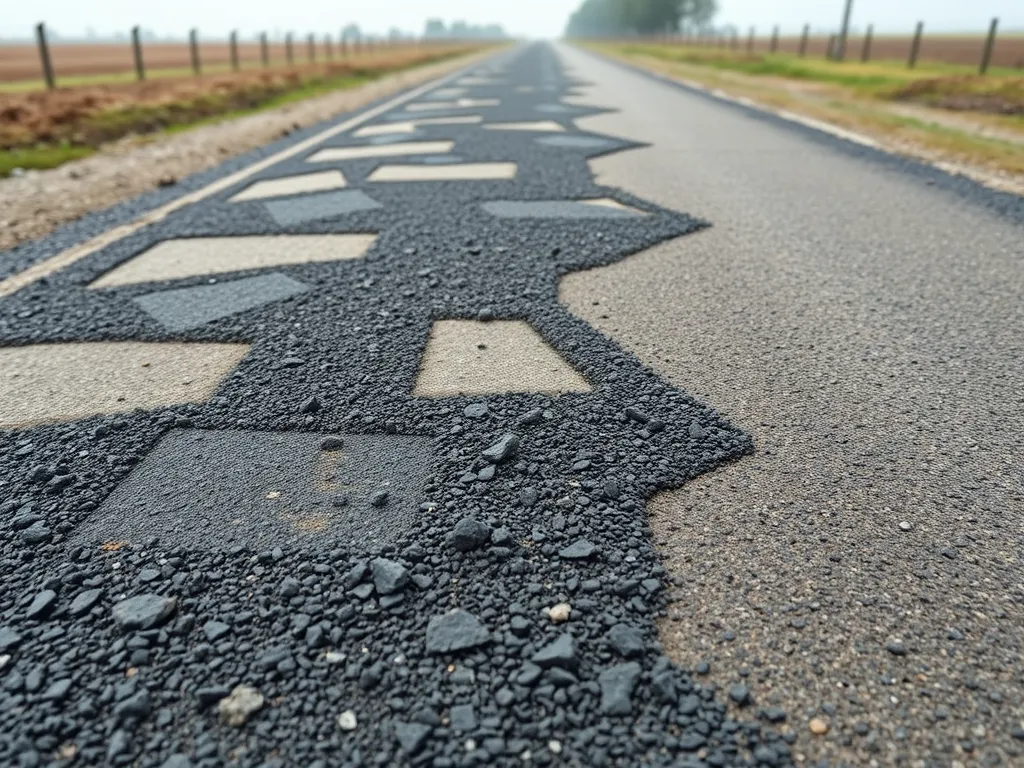Cost-effective Cold Mix Asphalt for Rural Roads: Benefits, Applications, and Practical Insights
Published on: October 17, 2025 | Last Updated: April 14, 2025
Written By: George Voss
Cold mix asphalt is a ready-to-use paving material made of aggregates and bitumen emulsion that requires no heating before application. Unlike hot mix asphalt (produced at 300-350°F), this mix stays workable in cold temperatures and handles light traffic on rural roads. It cuts costs by 30-50% compared to traditional methods, with prices ranging $25-$40 per ton. Rural crews use it for pothole repairs, shoulder maintenance, and temporary patches needing immediate use.
This article explores how cold mix asphalt works for low-volume roads. You’ll learn its composition differences from hot mix, see why it uses 50% less energy during production, and compare installation methods. We break down real-world uses like edge support repairs and emergency fixes during freezing weather. Get data on curing times (24-72 hours), load capacity limits (under 1,000 vehicles/day), and recycling rates (95% reusable).
Contents
- What is Cold Mix Asphalt?
- Cold Mix Asphalt Vs Hot Mix Asphalt
- Benefits Of Cold Mix Asphalt for Rural Roads
- Primary Applications Of Cold Mix Asphalt
- Cold Mix Asphalt Application Methods
- Calculating Material Requirements
- Performance Considerations
- Disadvantages Of Cold Mix Asphalt
- Environmental Impact Of Cold Mix Asphalt
- Frequently Asked Questions (FAQs)
- Closing Thoughts
- Useful References for You:
What is Cold Mix Asphalt?
Cold mix asphalt provides rural road crews with a versatile repair material requiring zero heating. Unlike traditional hot mixes, it stays workable in cool conditions and handles quick fixes without heavy machinery.
Definition and Composition
Cold mix asphalt contains aggregates (crushed stone, sand), liquid asphalt binder, and additives like emulsifiers or solvents. The binder stays liquid at ambient temperatures—either through emulsification (water-based) or chemical additives. Rural contractors favor polymer-modified versions (PG 64-22 binders) for better cohesion in wet climates. A typical mix uses 4-6% bitumen by weight with aggregates sized between 3/8″ and #200 sieve.
Key Differences From Hot Mix Asphalt
Hot mix asphalt requires heating to 300-350°F during production. Cold mix works at 50-80°F. This cuts energy use by 65-80% and eliminates greenhouse gas emissions from burners. While hot mix gains strength through cooling, cold mix hardens via solvent evaporation or emulsion breaking—a slower process taking 1-3 days. Rural projects benefit from cold mix’s ability to set without compaction in remote areas. Hot mix lasts 15-20 years on highways; cold mix serves 2-5 years on low-traffic roads but costs $25-$40 per ton versus $80-$120 for hot mix.
With these properties clarified, let’s examine how cold mix compares directly to hot mix across critical factors.
Cold Mix Asphalt Vs Hot Mix Asphalt
Rural road projects demand materials balancing performance and practicality. Comparing cold mix asphalt (CMA) and hot mix asphalt (HMA) reveals critical differences shaping project outcomes.
Material Preparation and Application Temperatures
CMA uses emulsified asphalt binders activated at ambient temperatures (50°F–85°F). No heating plants or specialized equipment needed. HMA requires heating aggregates and bitumen to 300°F–350°F, demanding continuous heat during transport. This makes CMA ideal for remote locations lacking infrastructure.
Cost and Energy Efficiency Comparison
| Factor | Cold Mix Asphalt | Hot Mix Asphalt |
|---|---|---|
| Production Cost/Ton | $20–$40 | $100–$150 |
| Energy Use (BTU/ton) | 40,000 | 400,000 |
| Stockpile Life | 6–12 months | 24–48 hours |
CMA cuts fuel consumption by 90% compared to HMA. Lower transport costs matter for rural projects—stockpiled CMA reduces repeat trips.
Cold Patch Vs Hot Patch Use Cases
Cold patch asphalt mix excels in emergency pothole repairs during rain or freezing conditions. It bonds without compaction equipment—simply fill and tamp. Hot patch asphalt requires dry conditions, heavy rollers, and achieves 10–15 years of service vs CMA’s 2–5 years. Rural agencies prioritize CMA for shoulder repairs, crack sealing, and temporary fixes where traffic stays below 500 vehicles/day.
With cost and logistics clarified, let’s explore specific benefits driving CMA adoption in rural infrastructure.

Benefits Of Cold Mix Asphalt for Rural Roads
Cold mix asphalt offers unique advantages for rural road maintenance. Its flexibility and adaptability make it a go-to solution for remote areas facing budget constraints and unpredictable weather. Let’s break down why it’s gaining traction.
Cost-effectiveness for Low-volume Roads
Cold mix asphalt cuts costs by 30-50% compared to hot mix. No heating during production slashes energy use, saving $15-$25 per ton. Rural roads with light traffic—under 500 vehicles daily—don’t need high-performance surfaces. This material handles infrequent use while keeping project budgets below $5,000 for typical half-mile repairs. No specialized storage or transport adds to savings.
All-weather Application and Durability
Apply cold patch asphalt even at 20°F or during light rain. Modified binders like CSS-1H or CRS-2 resist water penetration, preventing freeze-thaw damage. Field tests show cold mix lasts 3-5 years in rural settings, outperforming gravel in snowbelt regions. Additives like latex polymers boost cohesion, reducing raveling under truck tires.
Ease Of Installation With Minimal Equipment
- No paver needed: Spread with shovels or small spreaders
- Compact using hand tampers or single-drum rollers
- Mix onsite with portable pugmills (optional)
Crews of two can fix 10+ potholes daily. No waiting for hot plants to open—bagged cold asphalt mix works year-round.
Immediate Accessibility After Repairs
Drive on cold patch asphalt right after compaction. No curing delays—critical for farm equipment routes or emergency access roads. While full strength develops over 2-6 weeks, initial stability comes from angular aggregate interlock. Traffic compacts it further, improving density up to 92%.
These benefits position cold mix as a practical fix for rural networks. Next, we’ll explore specific repair scenarios where it outperforms traditional methods.
Also See: ASTM D2041 (Theoretical Maximum Specific Gravity – Rice Test)
Primary Applications Of Cold Mix Asphalt
Cold mix asphalt serves as a versatile solution for rural road maintenance. Its unique properties make it ideal for specific repair scenarios where traditional hot mix isn’t practical or cost-effective.
Pothole Repair and Pavement Patching
Rural roads face constant wear from weather and infrequent maintenance. Cold mix asphalt excels at rapid fixes for damaged surfaces.
Cold Asphalt Mix for Potholes
Cold patch asphalt requires no heating before application. Crews fill potholes directly from the bag, compacting the material with hand tampers or rollers. Brands like EZ Street or QPR use modified binders (often PG 64-22) that cure under traffic, creating semi-permanent repairs. A typical 50lb bag covers 12-15 sq.ft at 2” depth, costing $4-$8 per bag.
Surface Disruption Repairs
Utility cuts, animal burrows, and washboard ruts destabilize road bases. Cold mix asphalt for pavement repairs seals these gaps quickly. Contractors layer material in 3” lifts, achieving 95% compaction with plate compactors. This prevents water infiltration – a key cause of frost heave in rural climates.
Shoulder Maintenance and Edge Support
Gravel shoulders erode over time, causing road edges to crumble. Cold lay asphalt binds loose aggregate, creating 18”-24” reinforced edges. Agencies apply 3-4” thick layers angled at 30 degrees from pavement. This extends road life by 5-7 years at $25-$40/ton – 60% cheaper than hot mix alternatives.
Preventive Maintenance for Rural Road Preservation
Proactive strategies use cold patch sealer for crack filling and surface rejuvenation. Fog seals (0.10-0.15 gal/sq.yd) blend emulsified asphalt with cold mix fines to restore flexibility. Annual treatments reduce major repairs by 35%, as per NCHRP Report 823. Some blends incorporate 15-20% recycled asphalt pavement (RAP), cutting material costs by $12/ton.
Proper application techniques directly impact repair longevity. Let’s examine the equipment and methods that ensure cold mix asphalt performs at its peak.

Cold Mix Asphalt Application Methods
Cold mix asphalt offers flexible use for rural roads. Its methods range from quick hand fixes to machine-driven projects. Each approach suits specific repair needs and road conditions.
Manual Application for Small-scale Repairs
Hand tools tackle potholes and cracks fast. Workers shovel cold asphalt mix into holes, pack it with tampers, and level it. No heat or heavy gear is needed. A 50-pound bag of cold patch asphalt mix can fill 2-3 square feet at 2-inch depth. This works for urgent fixes in remote spots with limited access.
Machine-assisted Layering Techniques
For large patches or full road sections, machines boost speed. Motor graders spread cold mix asphalt evenly. Pneumatic rollers compact layers up to 4 inches thick. This cuts labor time by 60% versus manual work. Proper compaction hits 93-96% density, matching hot mix strength for light traffic zones.
Binders and Additives for Enhanced Durability
Modified binders upgrade standard cold asphalt. Polymer-based mixes resist water damage and cracking below 40°F. Additives like lime or cement boost load-bearing power for farm gear or school buses. Some blends last 5-8 years on rural routes with under 500 cars daily.
Planning your cold mix project? Accurate quantity estimates prevent waste and budget slips. Let’s break down how to calculate needs for rural road jobs.
Calculating Material Requirements
Effective planning for rural road repairs starts with precise material estimates. Cold mix asphalt projects require tailored calculations due to unique density profiles and application methods.
Estimating Quantity for Road Repairs
Measure the repair site’s length, width, and depth in feet. Multiply these dimensions to get cubic feet. Convert to cubic yards by dividing by 27. Cold mix asphalt weighs roughly 1.25 tons per cubic yard. For example, a 10ft x 4ft x 0.25ft pothole needs (10×4×0.25)/27 = 0.37 cubic yards, requiring 0.46 tons of cold patch asphalt mix. Always factor 10-15% extra material for compaction losses.
Cost Per Ton Of Cold Mix Asphalt
Prices range between $35-$65 per ton based on location, order size, and mix specifications. High-performance blends with polymer-modified binders cost up to 20% more but provide better rut resistance. Compare this to hot mix’s $90-$130/ton pricing. Bulk orders exceeding 50 tons often trigger volume discounts.
| Material | Cost/Ton | Typical Coverage |
|---|---|---|
| Standard Cold Mix | $35-$50 | 160 sq.ft. at 2″ depth |
| Polymer-Modified | $55-$65 | 180 sq.ft. at 2″ depth |
Using Asphalt Calculators for Project Planning
Online tools like the Asphalt Calculator USA platform let users input project dimensions to generate instant quantity estimates. These systems factor in regional material densities and compaction rates. For rural roads spanning multiple miles, such tools reduce over-ordering risks by 22% on average. Input parameters must include traffic levels (light vs medium) to determine optimal layer thicknesses.
With material needs quantified, the next focus turns to maximizing pavement performance under real-world conditions.

Performance Considerations
Cold mix asphalt offers unique advantages for rural road maintenance but requires careful evaluation of its operational limits. Performance hinges on three critical factors: curing behavior, temperature resilience, and traffic capacity.
Curing Time and Hardening Process
Cold mix asphalt hardens through evaporation of emulsified asphalt binders rather than heat-induced compaction. Initial curing takes 24-72 hours at 50°F, with full strength achieved in 2-6 weeks depending on humidity and layer thickness. Rural projects often use polymer-modified mixes (e.g., CMS-2P or CMS-2S grades) to accelerate bonding. Though traffic can use repaired areas immediately, restrict heavy loads (>3 tons) during the first 72 hours.
Durability Under Mild and Cold Temperatures
This material performs optimally in temperatures between 20°F and 85°F. Its flexibility prevents cracking in freezing conditions – a key advantage over rigid hot mix surfaces. In sub-40°F climates, cold patch asphalt retains 85-90% compaction efficiency compared to hot mix’s 60% limit. However, sustained heat above 90°F may soften surfaces, reducing rut resistance by 15-20% versus hot mix. Fiber-reinforced blends mitigate this for farm-to-market routes.
Limitations in Heavy Traffic Areas
Cold mix asphalt supports up to 300 PSI load capacity – adequate for rural roads with under 500 vehicles/day. It struggles with frequent heavy trucks (>10,000 lbs axle loads), showing 2-3x faster rutting than hot mix in controlled studies. For high-traffic rural intersections or grain haul routes, combine cold mix bases with hot mix overlays. The National Asphalt Pavement Association recommends cold mix only for roads with under 10% truck traffic.
While performance factors guide material selection, cold mix asphalt has specific limitations that impact long-term road management strategies.
Disadvantages Of Cold Mix Asphalt
Cold mix asphalt works well for quick rural road fixes but has clear trade-offs. Let’s break down its key weak spots.
Reduced Longevity Compared to Hot Mix
Cold mix lasts 3-7 years vs hot mix’s 15-20 years. The cutback binders (like MC-30) take weeks to cure fully. This slow cure leaves roads soft at first, prone to rutting under heavy farm gear. Cold patch asphalt mix also wears faster in rain or snow due to more air voids (8-12% vs 3-5% in hot mix).
Surface Texture and Aesthetic Limitations
Cold lay asphalt forms a rough, loose top layer. It lacks the smooth finish of hot mix since it’s not pressed at high heat. This coarse texture traps dirt and speeds up wear. Rural roads patched with cold asphalt mix may show uneven shades where old and new blends meet, making repairs stand out.
While cold mix asphalt for pavement repairs solves urgent needs, these gaps matter for long-term plans. Next, let’s see how its green perks stack up against other options.

Environmental Impact Of Cold Mix Asphalt
Cold mix asphalt brings clear green gains for rural roads. Its low-heat process and reuse cuts harm to air, land, and resources. Let’s break down how it works.
Lower Carbon Footprint
Cold mix skips the high heat used in hot asphalt. Hot mixes cook at 300°F+, burning fuel and pumping out 35% more CO2. Cold mix forms at air temps, slashing energy use by half. Less truck trips help too—it stays workable for weeks, so plants can ship it farther without waste. Tests show rural jobs with cold mix cut 12-18 tons of CO2 per mile vs hot mix.
Recyclability and Sustainable Practices
Old roads feed new ones with cold mix. Up to 100% reclaimed asphalt pavement (RAP) can go into mixes, saving 3.2 tons of rock and bitumen per 100 tons made. Unlike hot mix, cold recycled roads don’t weaken over cycles. Bio-binders from plants now replace some oil-based glue in mixes. LEED green builds give points for this, and towns save $8-$15 per ton with RAP blends.
With these eco pluses, cold mix fits rural needs well. Next, we’ll answer top user questions on how to apply it right.
Frequently Asked Questions (FAQs)
How Long Does Cold Mix Asphalt Take to Harden?
Cold mix asphalt typically takes 24 to 72 hours to harden, depending on environmental conditions such as temperature and humidity. Full strength may take anywhere from 2 to 6 weeks to achieve, but it can be used for light traffic immediately after application.
What Are the Disadvantages Of Cold Mix Asphalt?
Some disadvantages of cold mix asphalt include reduced longevity compared to hot mix asphalt, a rougher surface texture, and potential issues with raveling and wear under heavy traffic. It generally lasts 3-7 years, while hot mix can withstand 15-20 years of use.
When Should Cold Mix Asphalt Be Used?
Cold mix asphalt is ideal for low-traffic rural roads, emergency pothole repairs, and projects that require quick application in adverse weather conditions. It is particularly useful when temperatures are too low for hot mix asphalt application or when immediate road availability is necessary.
What is the Cost Of Cold Mix Asphalt Per Ton?
The cost of cold mix asphalt typically ranges from $35 to $65 per ton, depending on factors such as the location and specific properties of the mix. In comparison to hot mix asphalt, which can range from $90 to $130 per ton, cold mix provides a more budget-friendly solution for rural road repairs.
Closing Thoughts
Cold mix asphalt presents a practical solution for rural roads. Its ability to be applied in various weather conditions makes it suitable for unpaved and low-traffic areas. The cost-effectiveness of cold mix allows communities to address road repairs without burdening budgets. This material offers quick solutions and minimal downtime for road users.
For optimal usage, it’s essential to consider specific site conditions and the expected lifespan of repairs. While cold mix asphalt may not match hot mix asphalt’s durability, its immediate accessibility is a significant advantage for rural infrastructure maintenance. By understanding these factors, you can make informed decisions that benefit your local roadways.
For more information and to assist with your asphalt projects, check out Asphalt Calculator USA.
Useful References for You:
- The Asphalt Institute (Technical Resources & Standards)
- Hot Mix Vs. Cold Mix Asphalt: Which One Is Better For Your Road Project? – LeeBoy®
- Cold Mix Asphalt: The Perfect Solution For Municipal Street Pothole Patching and Repairs
- Hot Mix vs Cold Mix Asphalt – Advantages and Disadvantages
- 5 Benefits of Choosing Cold Mix Asphalt Over Hot Mix | by High Roads | Medium


